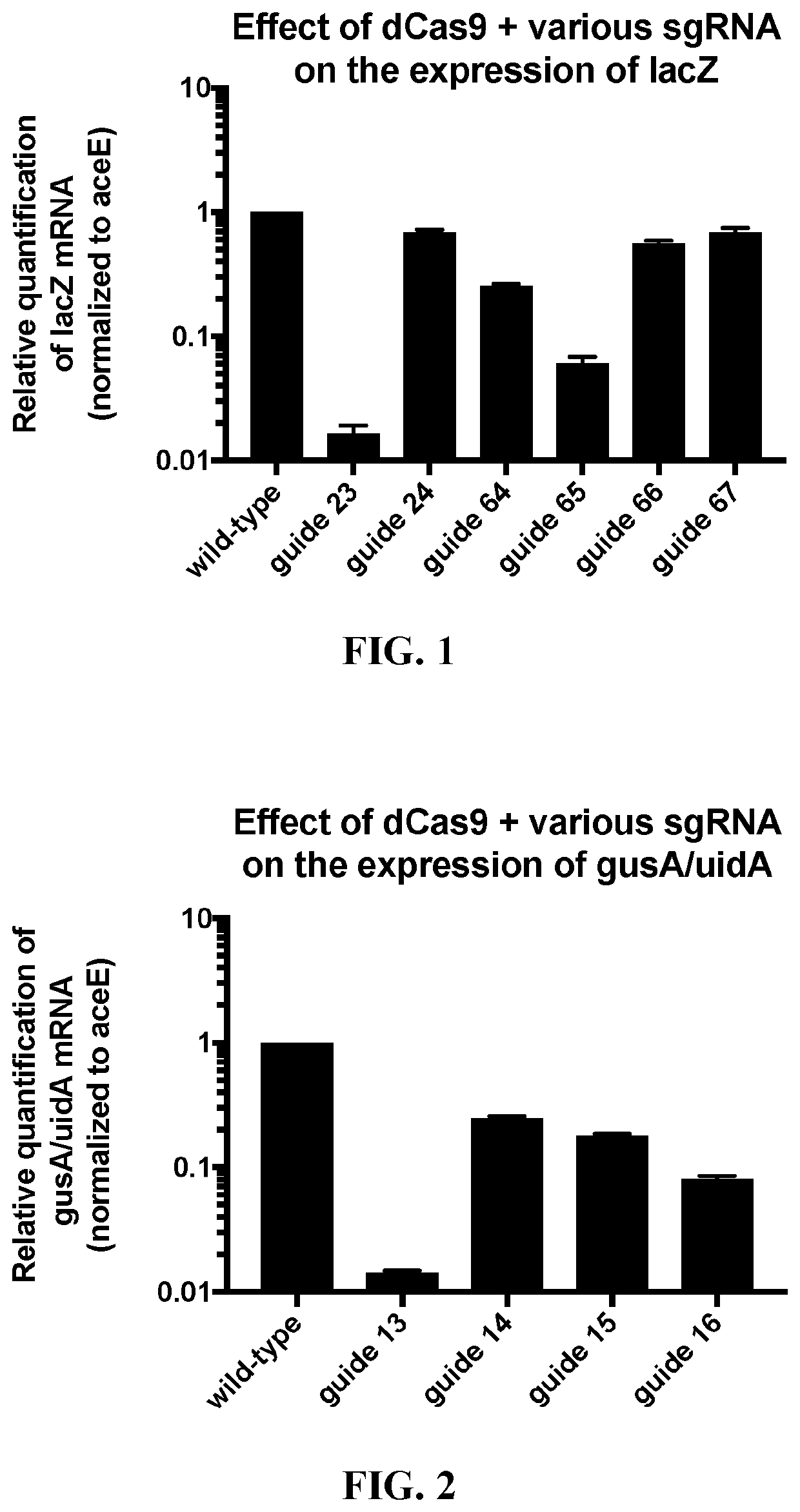Engineered gut microbes and uses thereof
a technology of gut microorganisms and xenobiotic agents, which is applied in the direction of enzymology, biochemistry apparatus and processes, transferases, etc., can solve the problems of reducing the pharmacokinetics of drugs, affecting so as to reduce the reactivation of detoxified drugs, prevent the reactivation of drugs, and reduce the adverse drug effects of xenobioti
- Summary
- Abstract
- Description
- Claims
- Application Information
AI Technical Summary
Benefits of technology
Problems solved by technology
Method used
Image
Examples
example 1
n of Bacterial Strains for Use in Gene Editing
[0155]This example describes the construction of plasmids targeting endogenous genes in Escherichia coli for genome editing.
[0156]First, target nucleotide sequences in the lacZ gene (SEQ ID NOS: 22 and 23), gusA / uidA gene (SEQ ID NOS: 24 and 25), gusB (SEQ ID NOS: 47 and 48), and gusC (SEQ ID NOS: 49 and 50) in the genome of E. coli strain MG1655 were identified (SEQ ID NOS: 1-20), using techniques known in the art. See, e.g., Jinek et al., Science (2012) 337:816-821; PCT Publication No. WO 2013 / 176772, published Nov. 28, 2013; and U.S. Pat. Nos. 10,000,772; 10,113,167; each incorporated herein by reference in its entirety. Two plasmids were constructed, one that expressed dCas9 (SEQ ID NO: 21) under the control of the tet promoter, and another that produced cognate sgRNAs (SEQ ID NOS: 27-36) complementary to a target nucleotide sequence in E. coli MG1655 (SEQ ID NOS: 1-20) under the control of the tet promoter. Nucleotide sequences in T...
example 3
ion of Broad-Host Range Plasmids for In Vivo Conjugation
[0166]Plasmids for in vivo conjugation of genetic material with GI tract microbes are constructed as follows. As explained herein, bacterial conjugation requires two plasmids: a mobilization plasmid carrying genes that encode for the enzymes that transfer the donor plasmid, and a donor plasmid carrying the genes to be delivered to a new organism. A mobilization plasmid for use herein is modeled after pTA-Mob, and the donor plasmid contains oriT, as well as the genes required for turning off the β-glucuronidation genes of the target gut organisms.
Construction of Mobilization Plasmid
[0167]A broad-host range mobilization plasmid with transfer functions is created. Plasmid pTA-Mob (Strand et al., pLoS One (2014) 9:e90372), a broad-host range mobilization plasmid, is used as a template for the new construct. The mobilization plasmid, pTA-Mob, contains the following components: Gmr is a gentamycin-resistant gene; rep is the pBBR1 rep...
example 5
of Other Bacteria from Human Donor Fecal Samples
[0177]This Example provides a description of the isolation of other bacteria from human donor fecal samples. This Example is adapted from the protocols known in the art. See, e.g., Kabiri et al, Can. J. Microbiol. (2013) 59:771-777; Livingston et al., J. Clin. Microbiol. (1978) 7:448-453; Fathi et al., The Open Micorbiol. J. (2016) 10:57-63; Hartemink et al., J. Microbiol. Meth. (1999) 36:181-192; Rogosa et al. J. Bacteriol. (1951) 62:132.
[0178]Strains of target bacteria are isolated from human donor fecal samples using selective growth media plating techniques. Human donor fecal samples are homogenized in PBS and serially diluted by a factor of ten in PBS. The homogenized and diluted fecal samples are then spread on selective agar plates for the specific bacteria (Table 2) and incubated for an appropriate time, at a temperature and environment conducive to the specific growth conditions of the target bacterial species. Bacterial colon...
PUM
| Property | Measurement | Unit |
|---|---|---|
| w/w | aaaaa | aaaaa |
| concentration | aaaaa | aaaaa |
| concentrations | aaaaa | aaaaa |
Abstract
Description
Claims
Application Information
 Login to View More
Login to View More - R&D
- Intellectual Property
- Life Sciences
- Materials
- Tech Scout
- Unparalleled Data Quality
- Higher Quality Content
- 60% Fewer Hallucinations
Browse by: Latest US Patents, China's latest patents, Technical Efficacy Thesaurus, Application Domain, Technology Topic, Popular Technical Reports.
© 2025 PatSnap. All rights reserved.Legal|Privacy policy|Modern Slavery Act Transparency Statement|Sitemap|About US| Contact US: help@patsnap.com

